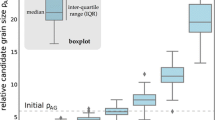Abstract
It is shown that the classical picture of a grain boundary in terms of a single array of lattice dislocations is incomplete. In addition, it is also necessary to incorporate into the boundary a second array of continuously distributed surface dislocations of infinitesimal strength and of opposite sign to those of the lattice dislocations, but with the same total magnitude. Furthermore, the lattice dislocations can also dissociate into a continuous distribution by the formation of cores. As the angular misorientation of the grain boundary increases, more and more of the surface dislocations combine with the lattice dislocations, in turn resulting in the formation of a larger and larger stress-free ledge, with a consequent overall reduction in the strength of the remaining lattice dislocation.
Similar content being viewed by others
References
F. L. Vogel, W. G. Pfann, H. E. Corey andE. E. Thomas,Phys. Rev. 90 (1953) 489.
J. C. M. Li, “Electron Microscopy and Strength of Crystals”, edited by G. Thomas and J. Washburn (Interscience Publishers, New York, 1963) p. 713.
S. Amelinckx andW. Dekeyser, “Solid State Physics” Vol. 8, edited by F. Seitz and D. Turnbull (Academic Press, New York, 1959) p. 325.
J. P. Hirth andJ. Lothe, “Theory of Dislocations” (McGraw-Hill Book Company, New York, 1968).
M. J. Marcinkowski, “Unified Theory of the Mechanical Behavior of Matter” (John Wiley and Sons, New York, 1979).
M. J. Marcinkowski,Phys. Status Solidi (a)60 (1980) 109.
K. Jagannadham andM. J. Marcinkowski,ibid 50 (1978) 293.
Idem, ibid 54 (1979) 715.
A. H. Cottrell,“Dislocations and Plastic Flow in Crystals” (Claredon Press, London, 1953).
M. J. Marcinkowski andK. Jagannadham,Phys. Status Solidi (a)50 (1978) 601.
K. Jagannadham andM. J. Marcinkowski,Cryst. Lattice Defects 8 (1979) 81.
Idem, J. Mater. Sci. 15 (1980) 563.
M. J. Marcinkowski, “Dislocation Modelling of Physical Systems” edited by M. F. Ashby, R. Bullough, C. S. Hartley and J. P. Hirth (Pergamon Press, New York, 1981) p. 342.
Author information
Authors and Affiliations
Rights and permissions
About this article
Cite this article
Marcinkowski, M.J. A new approach to the theory of grain boundaries. J Mater Sci 18, 827–839 (1983). https://doi.org/10.1007/BF00745582
Received:
Accepted:
Issue Date:
DOI: https://doi.org/10.1007/BF00745582




